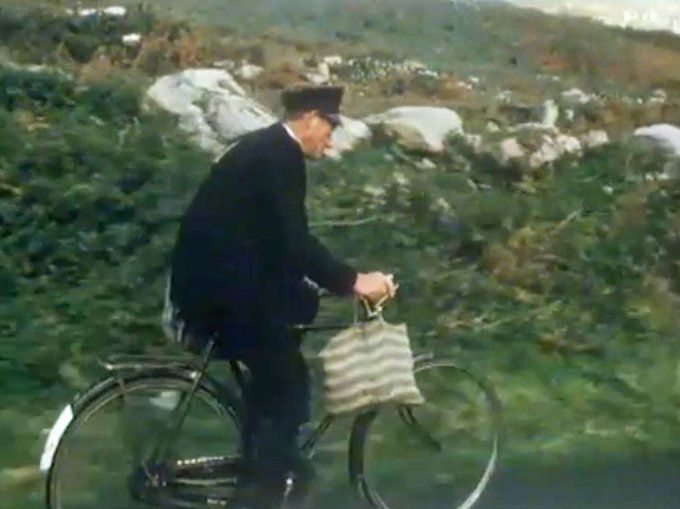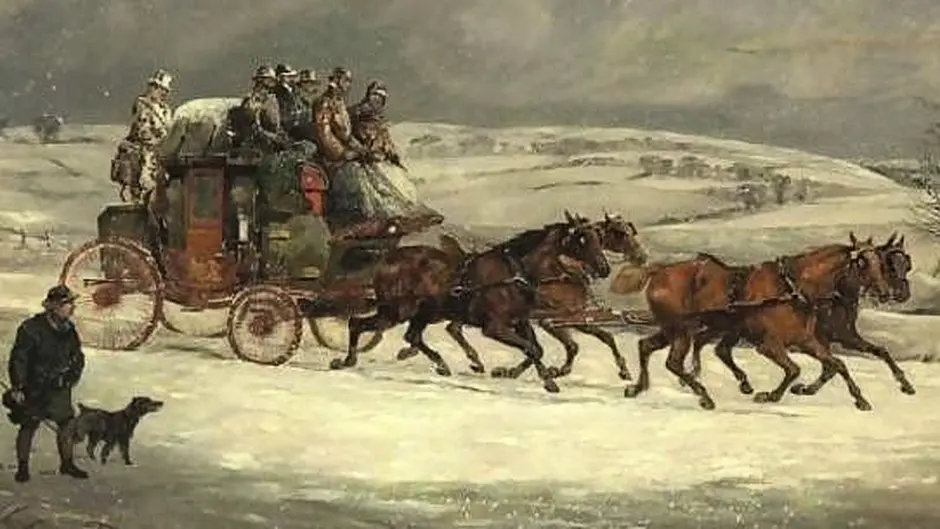As we start digging out the Christmas card lists and checking final times for posting the packages, Robert Hume looks back at the days of the old mail coaches, on the rocky roads of West Cork
WHAT image springs to mind if you think of the postie bringing Christmas cards and letters a couple of hundred years ago? Perhaps a coach, drawn by a fleet of horses, with blazing lamps, a vermillion-jacketed driver, collar pulled up against a blizzard, sounding a bugle to warn tollkeepers to open the gates so the precious post could get through.
At Christmas time, wrote author WT Palmer, ‘whisky flowed like water round the postman,’ who ‘be the day frosty or dirty, or merely unpleasant,’ brought up the mail – a letter from a distant friend, a surprise parcel.
‘One has known the Christmas mail come through the pass on a day of raging snow... them horses can either see, or hear, or smell their way in the worst storm as ever blew.’
John Anderson, once a herring seller in Glasgow, pioneered the mail coach service between Dublin and Cork in 1789. The contract for the first mail coach linking Cork to Skibbereen and Bantry was awarded in 1843 to former Kilkerran brewer Michael Gallwey, who lived in North Street, Skibbereen. Mail was stored in a box at the rear of his coach, four passengers were seated inside, and a few less fortunate ones outside.
Delivering the post posed a perennial challenge, especially to less accessible places such as Crookhaven in the extreme southwest, described by the Skibbereen Eagle in 1896 as ‘the next parish to America.’ Unlike the express mail connecting Cork and Dublin, mail coaches on rural routes moved slowly, in summer averaging 7-8mph, and in winter a mere 5mph.
Hummocky roads and lakes of mud caused delays. Novelist Anne Plumptre from Norwich had a particular problem with the stretch of rocky, mountainous road between Skibbereen and Bantry in 1815, describing her experience as ‘a new addition to the miseries of human life.’ Winter storms caused havoc, that of 1836 threatening London with a shortage of Irish turkeys. Some mail coaches were reportedly ‘missing for months.’
With the opening of the Cork & Bandon Railway in 1849, and the line’s gradual extension south, mail vans on trains began to replace mail coaches. Mailbags were collected at railway stations by horse and cart, and later by motorised ‘mail cars’.
But the service didn’t necessarily improve after this. Although the journey time by rail from Cork to Bantry was now reduced from six and a half hours to two hours, the mail train did not leave Cork until 3pm, so in Skibbereen and Bantry, letters were not delivered before nightfall. Complaints were still being made as recently as 2002 that the post was not arriving in outlying areas such as Castletownbere until 8pm, after the Bantry town mail had been delivered.
New rules stipulated that Christmas cards were only allowed to contain a message of five words, otherwise they would be charged the full letter rate of a penny. Loading and unloading into mail cars to meet train timetables meant more mishaps. At Christmas 1910, the ‘heavily laden’ car transporting mail between Courtmacsherry and Bandon railway station overturned.
Robberies occurred with disturbing regularity. On the morning of December 24th 1921, the Cork to Bantry mail train was held up at Waterfall, six miles south of Cork, when armed robbers appeared on the platform and threatened to shoot station staff if they raised the alarm. Some of the band scrambled on board the mail van, cut open the bags, and placed to one side any packets they believed to contain money. The Christmas Eve post was exceptionally heavy: 347 sacks had arrived in Cobh onboard the Baltic and the Centennial State the previous day, sent by Irish families in the USA as Christmas gifts to friends and relatives, many living in West Cork.
Locals would have recalled reading in the Skibbereen Eagle how the entire outward mail from Skibbereen had been seized by armed bandits a few months before, the Caheragh postman accosted at Dreeny, the Baltimore mail car held up at Creagh, the Leap mails seized near Shepperton, and postmen Gibbons, Crowley and Connolly ‘relieved of their correspondence.’
At Christmas 1926 four masked men held up a mail car travelling between Ballinhassig railway station, and Kinsale.
Having ordered the driver down a quiet lane, they seized registered letters and packets, and extracted any banknotes.
Bad weather and remoteness posed further difficulties. At Christmas 1932, the main street in Clonakilty was impassable because of torrential rain, and post office workers were marooned.
Bantry postmen had to row mail across to lighthouses, and to Dursey, Bere and Whiddy islands.
‘Possibly nowhere else in Ireland have postmen to encounter such hardships during the Christmas season”, claimed The Southern Star in 1929.
 Postman Mike Sheehan from Goleen on his rounds in West Cork, on his trusty bicycle. He wore out 22 bikes on his over-40 years in the postal service.
Postman Mike Sheehan from Goleen on his rounds in West Cork, on his trusty bicycle. He wore out 22 bikes on his over-40 years in the postal service.
Isolated farms made routes long, and mountain terrain meant steep climbs. Mike Sheehan from Goleen, who retired in the late 1970s, delivered letters, ‘rain or snow’, six days a week for over 40 years – including Christmas Day during the ‘30s and 40s – wore out 22 bikes in the process.
Dick Herlihy from Church Cross, Skibbereen, retired in 1987 after bringing the Christmas post for 42 years, regularly had the wheel arches of his much-loved orange postvan chewed by farm dogs.
It wasn’t ferocious dogs so much as a spate of huge ‘pussy cat’ greetings cards – some the size of a large newspaper – that challenged postmen in Courtmacsherry at Christmas 1977.
But year after year, under the expert supervision of the local postmasters – Mr Dwane at Bantry in the 1930s, Mr T Coakley at Clonakilty in the ’40s, and Mr M Hynes at Bandon in the ’50s – the mail has managed to get through before the ‘Big Day.’
It remains as true today as it was a century ago that a card or a letter, especially if it is personalised and hand written, ‘brightens Christmas’.
And who knows what might lie inside, quipped The Southern Star at Christmas 1929?
‘Times should be bad indeed when it doesn’t contain a money order for £5 or perhaps £20.’







